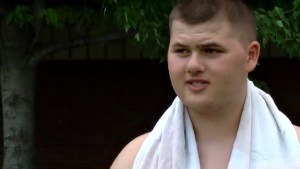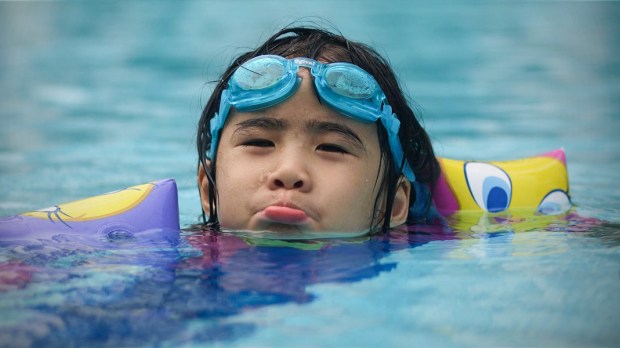After the recent dry drowning death of four-year-old Texan, Frankie Delgado, you may have noticed more articles on your social media pages on the dangers of secondary and dry drowning. Parents are concerned, and for good reason; not only is it difficult to tell if your child has had a secondary or dry drowning experience, the symptoms of these incidents can be confusing, with many resembling typical childhood ailments. So to try and get a bit more clarity, I spent the afternoon with two lifeguards discussing the ins and outs of drowning and keeping our kids safe as that cool refreshing water beckons.
What are secondary and dry drowning exactly?
According to lifeguard and ex-first responder, Isabelle Septier, there is a distinct difference between the two but both occur after the child has left the water, and both result in similar symptoms. Dry drowning happens when water is inhaled through the nose or mouth and triggers a spasm in the airways, causing severe breathing difficulties. Symptoms begin to show up not long after the child has left the body of water. The water does not reach the lungs, hence the name “dry” drowning.

Read more:
Lifeguard put to the test on day one: Saves 4-year-old
Secondary drowning, however, generally occurs anywhere from 1 to 24 hours after the swimmer has left the water but can happen over a number of days. (Although Frankie Delgado’s death happened one week after inhaling water, it was widely reported in the media as “dry” drowning. Dr Ray Pitetti of the Children’s Hospital of Pittsburgh of UPMC believes it was more a question of secondary drowning.) In the case of secondary drowning, water reaches the lungs and becomes an irritant. This creates a physiological reaction, so fluids build up in the lungs causing breathing difficulties.
What are the symptoms?
Septier says that if your child has inhaled water, or had difficulties in the water, to look out for a number of symptoms:
Severe drowsiness: Not just an “exhausted after the day at the beach” tiredness, but a sort of sluggishness that makes it difficult to rouse your child. The child may even hallucinate and have difficulty focusing on a particular object.
Coughing: This is sometimes accompanied with vomit. The child is trying to clear their airways to get some much-needed oxygen.
Breathing difficulties: Look out for a child who is gasping for air or you can see their chest seems to be overworking.
Changes in behavior: This is tricky to detect sometimes in younger children but look out for unusual behavior or forgetfulness.
Pains in the chest: Your child might complain that their chest is sore.
What do you do if you suspect secondary or dry drowning?
Septier says that if you have the slightest doubt, head straight to the ER. Your child will need an exam to check their lungs and airways. If your child is diagnosed with secondary or dry drowning, their oxygen levels will be monitored. There is no miracle drug, but often the symptoms will pass; if they don’t your child may need to be intubated.

Read more:
Little girl’s recovery from a near-drowning being called miraculous
As many of the symptoms are similar to childhood illnesses, parents often feel like they are over-reacting taking their child to hospital in these circumstances. However, Septier says it’s much better to go for expert help and get an accurate diagnosis than to put your child at risk.
How can you prevent secondary or dry drowning?
Lifeguard and mom of a very active three-year-old boy Leïla Foufana has one very clear message: be vigilant! She says that parents are often too confident with their child’s swimming abilities. She also reminds us that any type of drowning experience can happen to anybody, of any age, and any swimming proficiency. Foufana explains that although only one to two percent of deaths by drowning are the result of secondary/dry drowning, it is still too many, and they are easily avoidable. However, water is fun and should be enjoyed in the right conditions so here are some key pointers she’d like to share with parents:
Stay alert: Children should make noise when they are in a pool. If there is no noise be concerned! Drowning is actually a quiet experience, not the shouting and flailing of arms we believe it to be. Also, kids often get into difficulty when parents think they are being observed by whoever else is in the pool. Don’t assume your kid is being looked after. And if you’re having a pool party with your neighbors or family, the golden rule is to assign a person to be lifeguard with no cellphone, no alcohol, no distractions.
Adult supervision: Do not leave older siblings who are still minors to “keep an eye out” on their little brothers and sisters, ever. It’s too much responsibility.
Suitable water aids: Make sure whatever armbands or seats you get for your kids are age and weight appropriate.
No food 30 minutes before entering the pool: Leave enough time for your food to digest before jumping in the water.
Alcohol and water don’t mix: This is more for the adults out there, however, it’s also a useful message to spread among teens who can’t resist breaking the odd rule!
Swimming lessons do not make an expert swimmer: Foufana believes children generally cannot learn to swim properly before their 6th birthday (obviously there may be occasional exceptions). By all means get younger kids to swim classes to gain ease and confidence in water but do not think your child is Michael Phelps before his time. They still need supervising at all times.
And on an extra-cautious note …
Make the kids take a break if they’re gulping in too much water: How many parents have thought their child has swallowed half the pool after a session? Foufana says that with the increased awareness of secondary and dry drowning, parents are on the lookout for any signs of danger. So if she sees a child gulping in too much water during her lessons, she asks them to leave the pool for the remainder of the session. It’s a strictly preventative measure but a question of better safe than sorry.
Share all the above advice: With an average of 10 deaths by drowning a day in the US, two of those affecting children 14 and under, there’s a lot we can do to prevent further tragedy. Even if you don’t have kids yourself, please feel free to share the lifeguards’ advice with friends and family who may be at risk.
And finally, don’t forget about traditional drowning. This video, which went around a few years back, is a good refresher on what it looks like — take a look and have a wonderful, safe summer!

